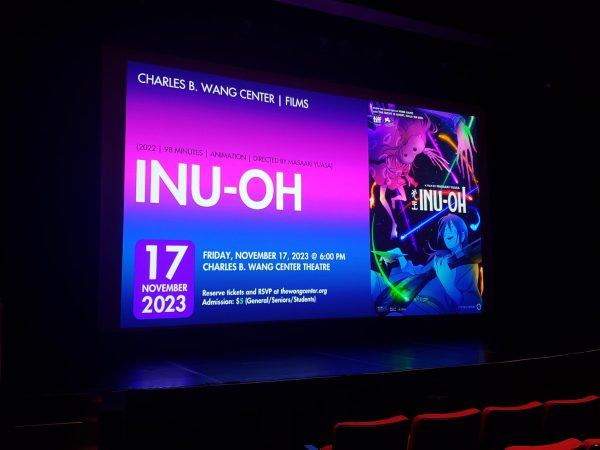
Director Masaaki Yuasa fuses rock and roll with 14th-century Japanese culture in his animated film “Inu-Oh,” which was screened on Nov. 17 as part of the Charles B. Wang Center’s fall film showings.
The film is based on the Japanese novel “Tales of the Heike: Inu-Oh” by Hideo Furukawa. “Inu-Oh” originally premiered in September 2021 at the 78th Venice International Film Festival before being released in Japanese theaters a year later.
Furukawa’s novel took inspiration from the Japanese classic “The Tale of the Heike,” which chronicled the events of the Genpei War between the Taira and Minamoto clans — also commonly referred to as the Heike and Genji clans, respectively.
“Inu-Oh” revolves around the budding friendship between Tomona, a blind biwa player, and Inu-Oh, an outcast Noh dancer. A biwa is a Japanese string instrument with a pear-shaped body used for narrative storytelling. Noh, a traditional Japanese form of theater incorporating music and dance, sets itself apart from other theatrical traditions since the donning of a mask is reserved for the principal actor.
Inu-Oh wears a mask for different reasons. Born with physical abnormalities, such as one arm being longer than the other and eyes placed oddly apart, he uses the mask as a shield to hide his face.
With Tomona’s help, Inu-Oh realizes that he is haunted by the spirits of deceased Heike soldiers, each with a story that has not been officially recorded in “The Tale of the Heike.”
Every time the pair tells a new story in an energetic magical number, Inu-Oh’s appearance transforms into what can be considered conventionally beautiful when the curse of the Heike spirits begins to lift. The popularity of Tomona and Inu-Oh’s performances’ grew, and so did the crowds who would clamor to watch them in action.
The anachronism of rock and roll in medieval-era Japan not only serves as a backdrop for the film’s psychedelic animation but also touches upon contemporary artists’ tendencies to push the boundaries of what is expected or deemed acceptable by, in this case, societal authority.
While the film’s visual style is occasionally overwhelming with its flashy effects, the scenes that focus on Tomona’s experiences as a blind person are the most satisfying to watch. Adopting a painterly limited color palette to contrast the dark backdrop, the animation gives shape to the sounds — footfalls, raindrops, laughter — that comprise Tomona’s world.
Avu-chan and Mirai Moriyama, who voice Inu-Oh and Tomona, respectively, shine the brightest in the song “Dragon Commander” when their vocals come together to tell the story of Inu-Oh’s origins. In previous performances, Tomona only sang to garner public attention for Inu-Oh and to introduce him to his enthusiastic audience.
Despite the film ending tragically with Tomona’s death at the hands of the shogunate, it exemplifies how artists’ rebellious natures are often quelled in violent ways, leaving room for possibility and imagination.
At its core, “Inu-Oh” is a story about stories and asks questions that modern audiences still grapple with today: How should these stories be told? Whose stories do we tell? Why do we continue to tell them, even if plenty would prefer they fade out of existence?
If you find yourself humming any of the film’s songs after watching, then it succeeded in its primary goal: to artfully immortalize stories in the hearts of those who consume them.













